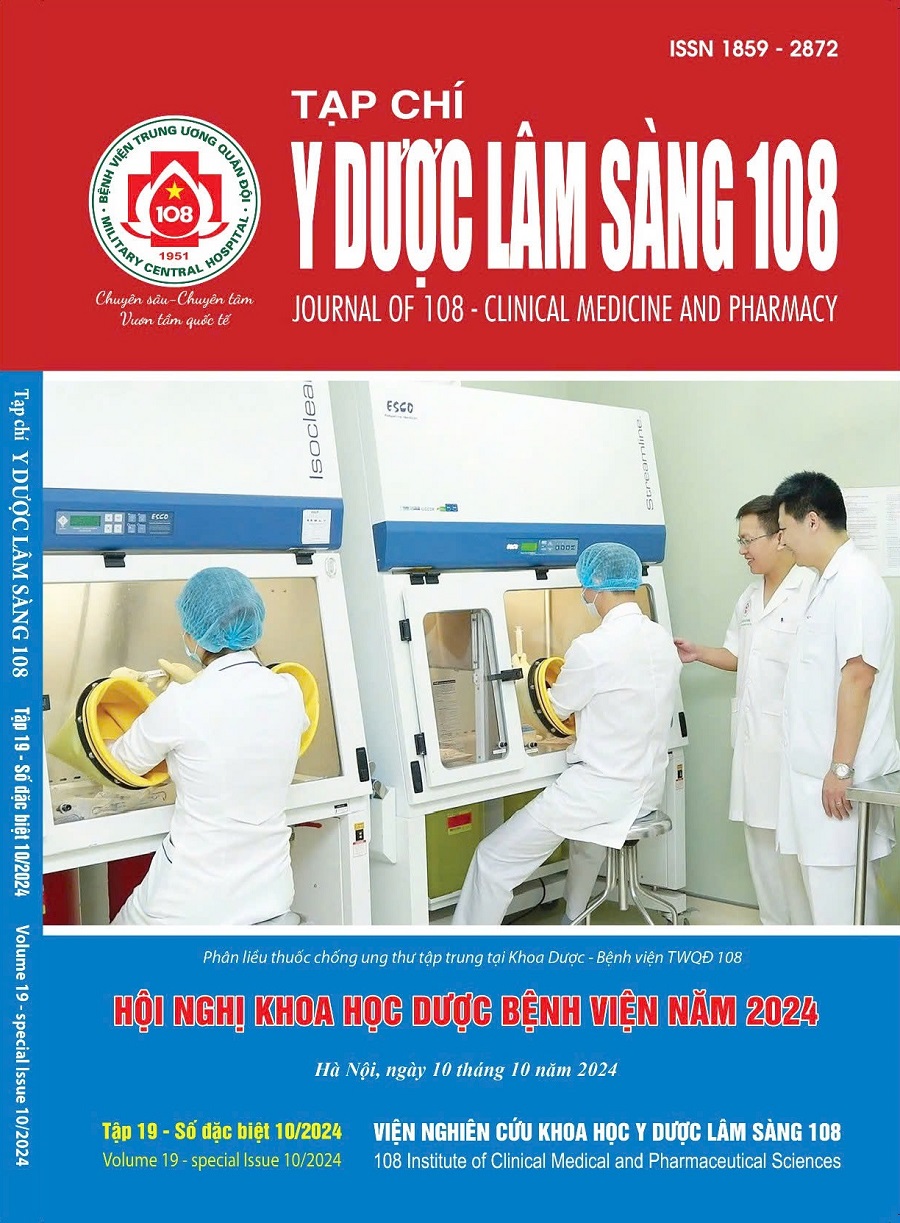Thẩm định ngoại tính phù hợp của mô hình dược động học quần thể vancomycin trên bệnh nhân trưởng thành tại Bệnh viện Trung ương Quân đội 108
Main Article Content
Keywords
Tóm tắt
Mục tiêu: Nghiên cứu được tiến hành nhằm xác định mô hình dược động học quần thể (popPK) vancomycin có khả năng dự đoán dược động học phù hợp nhất cho quần thể bệnh nhân tại Bệnh viện Trung ương Quân đội 108 (TƯQĐ 108). Đối tượng và phương pháp: Phương pháp thẩm định ngoại được sử dụng để đánh giá khả năng dự báo của các mô hình popPK vancomycin trong y văn, dựa trên bộ dữ liệu nồng độ vancomycin trong máu 98 bệnh nhân người trưởng thành tại bệnh viện từ tháng 12/2020 đến tháng 08/2022. Kết quả: 28 mô hình popPK vancomycin từ 270 nghiên cứu sàng lọc trong y văn được lựa chọn để thẩm định mức độ phù hợp. Mô hình Yamamoto-2 (2009) là mô hình có khả năng dự đoán tốt nhất nồng độ vancomycin thực tế với sai số dự đoán trung bình (MPE) và trung bình sai số dự đoán tuyệt đối (MAPE) lần lượt là 0,08mg/L và 18,9% (tương ứng mức độ dự đoán tốt). Các biểu đồ thể hiện mối quan hệ giữa nồng độ quan sát và nồng độ dự đoán (GOF, VPC) của mô hình cũng cho thấy độ khớp tốt giữa nồng độ dự đoán và nồng độ thực tế. Kết luận: Mô hình Yamamoto-2 (2009) được xác định có khả năng dự đoán nồng độ vancomycin tốt nhất cho bệnh nhân tại Bệnh viện TƯQĐ 108. Kết quả nghiên cứu này là cơ sở để phát triển công cụ định liều chính xác theo mô hình phù hợp, nhằm cải thiện hiệu quả hoạt động giám sát nồng độ thuốc trong máu tại bệnh viện trong tương lai.
Article Details
Các tài liệu tham khảo
2. Kumar AA, Burgard M, Stacey S, Sandaradura I, Lai T, Coorey C, Cincunegui M, Staatz CE, Hennig S (2019) An evaluation of the user‐friendliness of Bayesian forecasting programs in a clinical setting. British journal of clinical pharmacology 85(10):
2436-2441.
3. Turner RB, Kojiro K, Shephard EA, Won R, Chang E, Chan D, Elbarbry F (2018) Review and validation of Bayesian dose‐optimizing software and equations for calculation of the vancomycin area under the curve in critically ill patients. Pharmacotherapy 38(12): 1174-1183.
4. Fuchs A, Csajka C, Thoma Y, Buclin T, Widmer N (2013) Benchmarking therapeutic drug monitoring software: A review of available computer tools. Clinical pharmacokinetics 52: 9-22.
5. Keizer RJ, Ter Heine R, Frymoyer A, Lesko LJ, Mangat R, Goswami S (2018) Model-Informed Precision Dosing at the Bedside: Scientific Challenges and Opportunities. CPT Pharmacometrics Syst Pharmacol 7(12): 785-787.
6. Methaneethorn J, Lohitnavy M, Onlamai K, Leelakanok N (2022) Predictive performance of published tacrolimus population pharmacokinetic models in Thai kidney transplant patients. Eur J Drug Metab Pharmacokinet 47(1):105-116. doi: 10.1007/s13318-021-00735-8.
7. Parra González D, Pérez Mesa JA, Cuervo Maldonado SI, Díaz Rojas JA, Cortés JA, Silva Gómez E, Saavedra Trujillo CH, Gómez J (2022) Pharmacokinetics of vancomycin among patients with chemotherapy-associated febrile neutropenia: which would be the best dosing to obtain appropriate exposure? Antibiotics (Basel) 11(11):1523. doi: 10.3390/antibiotics11111523.
8. Yamamoto M, Kuzuya T et al (2009) Population pharmacokinetic analysis of vancomycin in patients with gram‐positive infections and the influence of infectious disease type. Ournal of clinical pharmacy and therapeutics 34(4): 473-483.
9. Medellín-Garibay SE, Ortiz-Martín B, Rueda-Naharro A, García B, Romano-Moreno S, Barcia E (2016) Pharmacokinetics of vancomycin and dosing recommendations for trauma patients. The Journal of antimicrobial chemotherapy 71(2): 471-479.
10. Moore JN, Healy JR et al (2016) A population pharmacokinetic model for vancomycin in adult patients receiving extracorporeal membrane oxygenation therapy. CPT: Pharmacometrics & systems pharmacology 5(9): 495-502.
11. Revilla N, Martin-Suarez A et al (2010) Fernandez de Gatta MdM: Vancomycin dosing assessment in intensive care unit patients based on a population pharmacokinetic/pharmacodynamic simulation. British journal of clinical pharmacology 70(2): 201-212.
12. Dolton M, Xu H, Cheong E, Maitz P, Kennedy P, Gottlieb T, Buono E, McLachlan AJ (2010) Vancomycin pharmacokinetics in patients with severe burn injuries. Burns: Journal of the International Society for Burn Injuries 36(4): 469-476.
13. Aljutayli A, Thirion DJG, Bonnefois G, Nekka F (2022) Pharmacokinetic equations versus Bayesian guided vancomycin monitoring: Pharmacokinetic model and model‐informed precision dosing trial simulations. Clinical and translational science, 15(4): 942-953.
14. Guo T, van Hest RM, Roggeveen LF, Fleuren LM, Thoral PJ, Bosman RJ, van der Voort PHJ, Girbes ARJ, Mathot RAA, Elbers PWG (2019) External evaluation of population pharmacokinetic models of vancomycin in large cohorts of intensive care unit patients. Antimicrob Agents Chemother 63(5):e02543-18. doi: 10.1128/AAC.02543-18.
15. Lê Bá Hải, Nông Hồng Thạch và cộng sự (2023) Thực trạng giám sát nồng độ vancomycin trong máu và hiệu chỉnh liều trên bệnh nhân người lớn điều trị tại Bệnh viện Trung ương Quân đội 108. Tạp chí y dược lâm sàng 108, tr. 159-166.
16. Cunio CB, Uster DW, et al (2021) Towards precision dosing of vancomycin in critically ill patients: An evaluation of the predictive performance of pharmacometric models in ICU patients. Clinical microbiology and infection: The official publication of the European Society of Clinical Microbiology and Infectious Diseases 27(5): 777-783.
17. Trương Thanh Long, Lê Bá Hải và cộng sự (2022) Thẩm định ngoại tính phù hợp của mô hình dược động học quần thể vancomycin trên bệnh nhân điều trị tại Bệnh viện đa khoa Xanh Pôn. Tạp chí Y học Việt Nam, 515(2), tr. 195-200.
 ISSN: 1859 - 2872
ISSN: 1859 - 2872
